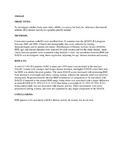Gender, body mass index and rheumatoid arthritis disease activity: results from the QUEST-RA Study.

View/
Date
2010-08Author
Jawaheer, D1
Olsen, J
Lahiff, M
Forsberg, S
Lähteenmäki, J
da Silveira, IG
Rocha, FA
Magalhães Laurindo, IM
Henrique da Mota, LM
Drosos, AA
Murphy, E
Sheehy, C
Quirke, E
Cutolo, M
Rexhepi, S
Dadoniene, J
Verstappen, SM
Sokka, T
QUEST-RA.
Oyoo, George O
Type
ArticleLanguage
enMetadata
Show full item recordAbstract
OBJECTIVES:
To investigate whether body mass index (BMI), as a proxy for body fat, influences rheumatoid arthritis (RA) disease activity in a gender-specific manner.
METHODS:
Consecutive patients with RA were enrolled from 25 countries into the QUEST-RA program between 2005 and 2008. Clinical and demographic data were collected by treating rheumatologists and by patient self-report. Distributions of Disease Activity Scores (DAS28), BMI, age, and disease duration were assessed for each country and for the entire dataset; mean values between genders were compared using Student's t-tests. An association between BMI and DAS28 was investigated using linear regression, adjusting for age, disease duration and country.
RESULTS:
A total of 5,161 RA patients (4,082 women and 1,079 men) were included in the analyses. Overall, women were younger, had longer disease duration, and higher DAS28 scores than men, but BMI was similar between genders. The mean DAS28 scores increased with increasing BMI from normal to overweight and obese, among women, whereas the opposite trend was observed among men. Regression results showed BMI (continuous or categorical) to be associated with DAS28. Compared to the normal BMI range, being obese was associated with a larger difference in mean DAS28 (0.23, 95% CI: 0.11, 0.34) than being overweight (0.12, 95% CI: 0.03, 0.21); being underweight was not associated with disease activity. These associations were more pronounced among women, and were not explained by any single component of the DAS28.
CONCLUSIONS:
BMI appears to be associated with RA disease activity in women, but not in men
Citation
Clin Exp Rheumatol. 2010 Jul-Aug;28(4):454-61. Epub 2010 Aug 30.Publisher
University of Nairobi
Collections
- Faculty of Health Sciences (FHS) [10415]
